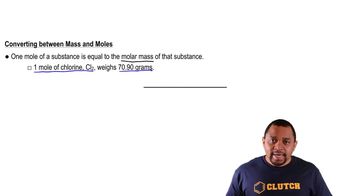Here are the essential concepts you must grasp in order to answer the question correctly.
Molar Mass
Molar mass is the mass of one mole of a substance, typically expressed in grams per mole (g/mol). For elements, it corresponds to the atomic weight found on the periodic table. For example, the molar mass of argon (Ar) is approximately 39.95 g/mol, which is essential for converting grams of an element to moles.
Recommended video:
Conversion from Grams to Moles
To convert grams of a substance to moles, the formula used is: moles = mass (g) / molar mass (g/mol). This relationship allows chemists to quantify the amount of substance in a sample, facilitating calculations in stoichiometry and chemical reactions.
Recommended video:
Mass and Moles Conversion
Stoichiometry
Stoichiometry is the branch of chemistry that deals with the quantitative relationships between the reactants and products in a chemical reaction. Understanding stoichiometry is crucial for determining how much of each substance is involved in a reaction, which is often based on the mole concept and molar mass calculations.
Recommended video:

 Verified step by step guidance
Verified step by step guidance


